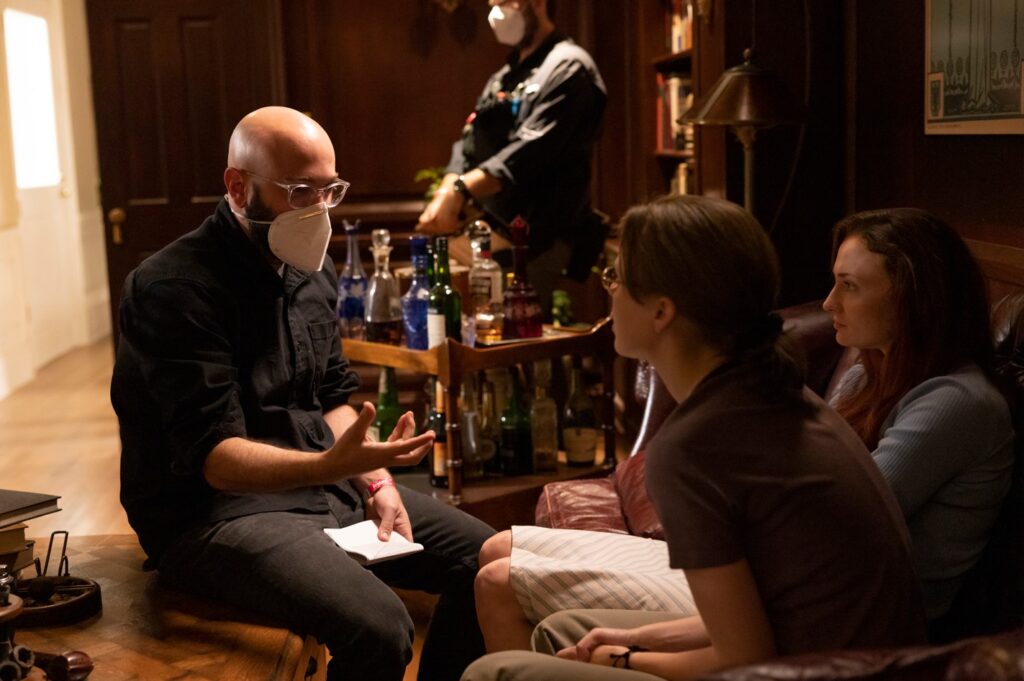Half of the roughly 25,000 murders committed in the United States each year go unsolved. So why, after over 20 years and over 20 movies, books, podcasts and TV shows, are we still obsessed with how Kathleen Peterson died in 2001?
“It’s about the uncertainty,” said Antonio Campos, the showrunner of “The Staircase,” this summer’s HBO Max eight-part docu-drama. The series earned critical acclaim and Emmy Award nominations for lead actors Colin Firth and Toni Collette, and it rekindled Staircase-mania in the media.
“With shows that are based on true crime or a documentary there’s a lot of people who have already kind of absorbed the story, learned about the story, read about it and debated it with their friends and families. So, I think people come in with their own set of opinions who know the case and the story and are curious about how it’s been dramatized,” Campos told me in a Zoom call from his home in Chile this summer, where he, his wife, who is Chilean, and his family were riding out the latest COVID variant.
The Staircase
A quick backtrack. On the balmy night of December 9, 2001, husband and wife, Michael and Kathleen Peterson sat by the pool outside their Durham, NC home sharing a bottle of wine. At some point, Kathleen went into the house. No one knows what happened next, other than the police found her dead in a pool of her own blood at the foot of a staircase after getting a 9-1-1 call from Michael.
“Everyone agreed the cause of death was exsanguination [caused by blunt force trauma]. It’s not a whodunnit, it’s a what happened,” David Rudolf, Peterson’s former defense attorney, told me in March.
A Durham County jury convicted Peterson of murder in 2003 and sentenced him to life in prison. In 2011 a new trial was ordered, and Peterson was released. In 2017, he chose not to have a second trial and entered an Alford plea of guilty of manslaughter but innocent of murder.
An Evolving Story
Campos got hooked on the Peterson case in 2008 when he saw the original 2004 eight-part French mini-series called “The Staircase.”
“I was reading a lot of true crime at the time, and I still read a lot of true crime. There wasn’t anything like ‘The Staircase’ documentary in 2008. There was nothing else where you could sit for eight hours and absorb and live in this world and explore every facet of a case,” recalled Campos.
“It was an immersive experience, one that got me really excited about diving in deeper. The reason I kept on for so long was because the story kept evolving. It kept changing. There was always something new to learn. There was always some new development or twist to process. This was a true mystery, and as much as we know, we will never really know.”
The Owl Theory
In the series, Campos presented three theories as to what might have happened to Kathleen: Michael Peterson beat her to death with a blunt instrument; he strangled her; or she bled to death after being attacked by an owl outside the home.
“From my perspective, the show doesn’t try to say any one of these theories is what happened,” said Campos. “We’re interested in the possibilities of what happened.”
Durham lawyer Larry Pollard posited that Kathleen went outside the house on the night of December 9 to set up some Christmas decorations. An owl in a nearby tree mistook her for a small animal and attacked her from behind, leaving deep gashes in the back of her head. Pollard believes she ran back into the house and bled out at the foot of the staircase.
A lot of people have sloughed off and ridiculed Pollard’s theory. But over the last 20 years he has assembled a plausible case despite there being “no smoking feather” as he told me this past spring.
Campos came to Durham in 2011 to meet with Pollard. “The thing about the owl theory, is when you first hear it, it sounds ridiculous,” said Campos. “But when you spend time with it, and especially when you spend time with Larry and he walks you through it, you start to go ‘hmmmmm!’ That doesn’t mean you become convinced. I think some people do become convinced of it. But even those who don’t have a moment of ‘maybe.’”
“The owl theory added another level of mystery to what was already a complicated mystery.
“I think that’s a very important moment because if that can pique your interest and get you to lean in for a moment, I think it’s worth paying attention to,” Campos continued. “The fact that there is her own blood under her fingernails was always something that was mysterious. And the idea that she was fighting off something overhead that caused her to react and finally there was the hair between the fingers. The drops of blood on the walkway outside, blood on the front door, the lack of defensive wounds, the small pinprick bruising, the pine needles and the presence of these small feather fragments.
“There is a big gap as well. You have to assume she went outside. You have to assume all these things for it to have happened. It’s a very compelling argument, but it’s still not complete. It requires a few more steps to be complete.”
Complex Characters
Campos’s version of “The Staircase” is richly woven together as more than just a who- or what-dunnit. Friends and members of the Petersons’ blended family who swirl around Michael and Kathleen in the story are complex, multi-layered, conflicted characters on their own journeys.
“In most of my work I try not to create people who are all good or all bad,” said Campos, whose other projects include the first season of Netflix’s “The Sinner” and movies like “The Devil All The Time,” “Martha Marcy May Marlene,” and the deeply disturbing “Christine.”
“Every character I like to create is operating under the assumption that what they’re doing is for the best,” explained Campos.
“They’re not operating under the assumption that they’re doing something wrong or bad, but that they are doing the right thing in the right moment, and that’s the best thing to do at that time.”
Uncertainty is Okay
“What kept me going with ‘The Staircase’ was the uncertainty. It wasn’t like, ‘Oh, I think if I spend 10 years on this, I’m going to solve it.’ It was more the mystery of it and living in the uncertainty and having to accept the uncertainty was what was so interesting to me,” said Campos.
“So much of the time, we’re looking for a definitive answer, and when there isn’t one, we force one to be there. What the show is trying to explore is, there are possibilities and uncertainty and at the end of the day, uncertainty is okay.”









